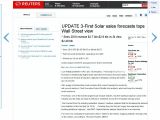Google is continuing to do more than it probably has to in order to appease the dying newspaper industry, though its efforts have largely gone unnoticed. About three months ago, Google revealed Fast Flip, an experimental tool designed to make browsing through articles from various online news sources fast and seamless while also hopefully generating some sort of revenue for the publishers and obviously itself. The company is now saying that the initial results are promising and that the program can be considered a success so far. It's not taking it out of Google Labs just yet, but it is announcing the addition of another 24 publishers and 55 publications to Fast Flip.
“[S]o far our initial thesis has held up: If you make it easier to read news online, people will read more of it. Users have told us they like being able to browse content so quickly, and we've been pleased with the amount of time they have spent reading articles in Fast Flip,” Jack Hebert, software engineer at Google, wrote. “Today, we're excited to be adding articles from another two dozen publishers representing more than 50 newspapers, magazines, web outlets, news wires and TV and radio broadcasters.”
The new publishers include Reuters, Tribune, The Huffington Post, Politico, and Fast Flip now has content from almost 100 newspapers, magazines, blogs or other news sources available. A mobile version of Fast Flip was also launched recently. Google says it will continue to improve the project and additional publishers in the future. The company is reiterating its commitment to helping the troubled industry turn things around.
However, Fast Flip, while great in theory, fails to impress or even deliver on its promise in practice. Yes, it's a very fast and convenient way of moving through different articles and publications. The app itself is everything you'd expect from Google, it's light, fast and functional. But all this is pointless, as actually reading the articles is downright impossible. In order to deliver on the speed, Google renders the sites itself and then presents the users with a 'screen shot' of the article.
The font quality could be better, significantly better actually, and you'll be missing out on any interactive element in the article, including things as basic as links. This isn't crucial for something like a magazine, but for a blog it severely decreases the value of the content. But even all this is a moot point, the full text of the articles is usually cut which means that if you actually want to read it, which presumably is why you're using Fast Flip, you have to go to the original source.
This leaves us with the question of what exactly is Google trying to achieve here. If it wants to be an innovative way to consume news content, it falls flat on its face, you can't actually read the articles. This is likely a conscious choice though, it's already getting a lot of heat from publishers for “stealing” their content. At best it could be used as an aggregator, a fast way of discovering interesting content and then moving to the original source to enjoy it, but Google News already fills that gap and Fast Flip certainly can't match it in almost any aspect.

 14 DAY TRIAL //
14 DAY TRIAL // 
